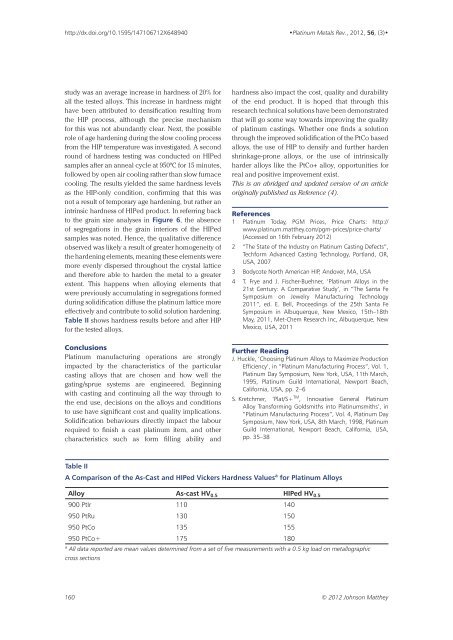Download article PDF - Platinum Metals Review
Download article PDF - Platinum Metals Review
Download article PDF - Platinum Metals Review
Create successful ePaper yourself
Turn your PDF publications into a flip-book with our unique Google optimized e-Paper software.
http://dx.doi.org/10.1595/147106712X648940<br />
•<strong>Platinum</strong> <strong>Metals</strong> Rev., 2012, 56, (3)•<br />
study was an average increase in hardness of 20% for<br />
all the tested alloys. This increase in hardness might<br />
have been attributed to densification resulting from<br />
the HIP process, although the precise mechanism<br />
for this was not abundantly clear. Next, the possible<br />
role of age hardening during the slow cooling process<br />
from the HIP temperature was investigated. A second<br />
round of hardness testing was conducted on HIPed<br />
samples after an anneal cycle at 950ºC for 15 minutes,<br />
followed by open air cooling rather than slow furnace<br />
cooling. The results yielded the same hardness levels<br />
as the HIP-only condition, confirming that this was<br />
not a result of temporary age hardening, but rather an<br />
intrinsic hardness of HIPed product. In referring back<br />
to the grain size analyses in Figure 6, the absence<br />
of segregations in the grain interiors of the HIPed<br />
samples was noted. Hence, the qualitative difference<br />
observed was likely a result of greater homogeneity of<br />
the hardening elements, meaning these elements were<br />
more evenly dispersed throughout the crystal lattice<br />
and therefore able to harden the metal to a greater<br />
extent. This happens when alloying elements that<br />
were previously accumulating in segregations formed<br />
during solidification diffuse the platinum lattice more<br />
effectively and contribute to solid solution hardening.<br />
Table II shows hardness results before and after HIP<br />
for the tested alloys.<br />
hardness also impact the cost, quality and durability<br />
of the end product. It is hoped that through this<br />
research technical solutions have been demonstrated<br />
that will go some way towards improving the quality<br />
of platinum castings. Whether one finds a solution<br />
through the improved solidification of the PtCo based<br />
alloys, the use of HIP to densify and further harden<br />
shrinkage-prone alloys, or the use of intrinsically<br />
harder alloys like the PtCo+ alloy, opportunities for<br />
real and positive improvement exist.<br />
This is an abridged and updated version of an <strong>article</strong><br />
originally published as Reference (4).<br />
References<br />
1 <strong>Platinum</strong> Today, PGM Prices, Price Charts: http://<br />
www.platinum.matthey.com/pgm-prices/price-charts/<br />
(Accessed on 16th February 2012)<br />
2 “The State of the Industry on <strong>Platinum</strong> Casting Defects”,<br />
Techform Advanced Casting Technology, Portland, OR,<br />
USA, 2007<br />
3 Bodycote North American HIP, Andover, MA, USA<br />
4 T. Frye and J. Fischer-Buehner, ‘<strong>Platinum</strong> Alloys in the<br />
21st Century: A Comparative Study’, in “The Santa Fe<br />
Symposium on Jewelry Manufacturing Technology<br />
2011”, ed. E. Bell, Proceedings of the 25th Santa Fe<br />
Symposium in Albuquerque, New Mexico, 15th–18th<br />
May, 2011, Met-Chem Research Inc, Albuquerque, New<br />
Mexico, USA, 2011<br />
Conclusions<br />
<strong>Platinum</strong> manufacturing operations are strongly<br />
impacted by the characteristics of the particular<br />
casting alloys that are chosen and how well the<br />
gating/sprue systems are engineered. Beginning<br />
with casting and continuing all the way through to<br />
the end use, decisions on the alloys and conditions<br />
to use have significant cost and quality implications.<br />
Solidification behaviours directly impact the labour<br />
required to finish a cast platinum item, and other<br />
characteristics such as form filling ability and<br />
Further Reading<br />
J. Huckle, ‘Choosing <strong>Platinum</strong> Alloys to Maximize Production<br />
Efficiency’, in “<strong>Platinum</strong> Manufacturing Process”, Vol. 1,<br />
<strong>Platinum</strong> Day Symposium, New York, USA, 11th March,<br />
1995, <strong>Platinum</strong> Guild International, Newport Beach,<br />
California, USA, pp. 2–6<br />
S. Kretchmer, ‘Plat/S+ TM , Innovative General <strong>Platinum</strong><br />
Alloy Transforming Goldsmiths into <strong>Platinum</strong>smiths’, in<br />
“<strong>Platinum</strong> Manufacturing Process”, Vol. 4, <strong>Platinum</strong> Day<br />
Symposium, New York, USA, 8th March, 1998, <strong>Platinum</strong><br />
Guild International, Newport Beach, California, USA,<br />
pp. 35–38<br />
Table II<br />
A Comparison of the As-Cast and HIPed Vickers Hardness Values a for <strong>Platinum</strong> Alloys<br />
Alloy As-cast HV 0.5 HIPed HV 0.5<br />
900 PtIr 110 140<br />
950 PtRu 130 150<br />
950 PtCo 135 155<br />
950 PtCo+ 175 180<br />
a All data reported are mean values determined from a set of five measurements with a 0.5 kg load on metallographic<br />
cross sections<br />
160 © 2012 Johnson Matthey
















